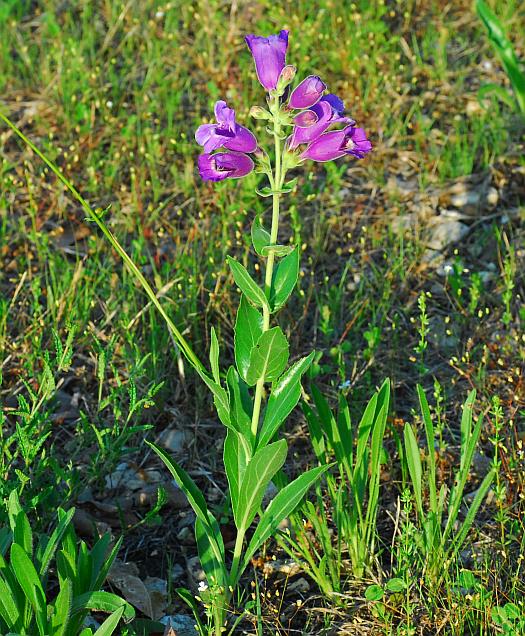Penstemon cobaea Nutt.
Cobaea Beard-Tongue

Native
CC = 10
CW = 5
MOC = 13
© SRTurner
Penstemon cobaea Nutt.Cobaea Beard-Tongue | |
 |
Native CC = 10 CW = 5 MOC = 13 |
© SRTurner |
|
Family - Plantaginaceae Habit - Perennial forb. Stems - Ascending to erect, to 80 cm, single or multiple from the base, sometimes from a spreading base, densely pubescent with mostly glandular hairs, the hairs slightly longer toward the stem tip, green, not glaucous.
Leaves - Basal and opposite, sessile. Basal leaves 3-24 cm long, the blade oblanceolate to spatulate, rounded to sharply pointed at the tip, tapered basally to a winged petiole, the margins usually sharply toothed, the surfaces glabrous to more commonly glandular-hairy, not glaucous. Stem leaves 3-15 cm long, the lowermost with the blade oblanceolate to narrowly oblong-elliptic, grading into lanceolate to ovate at the stem tip, sharply pointed at the tip, sessile or nearly so, the base of the lower blades tapered, grading through rounded to those of the uppermost leaves cordate and clasping, the margins sharply toothed, at least above the midpoint, the surfaces glabrous to more commonly glandular-hairy, not glaucous.
Inflorescence - Narrow axillary panicles, the central axis usually minutely glandular-hairy, green to yellowish green, not glaucous, with 3-6 nodes, each with a pair of leaflike, ovate, clasping bracts, these densely glandular pubescent, the branches ascending, with a pair of mostly branched clusters per node, each with 2-6 flowers. Pedicels glandular pubescent, 3-5mm long.
Flowers - Calyces 10-16 mm long at flowering, densely glandular-hairy, not glaucous, the lobes lanceolate to narrowly ovate. Corollas 35-55 mm long, the tube abruptly enlarged well below the midpoint, strongly bilabiate, the upper lip spreading to somewhat arched forward, the lower lip spreading to somewhat reflexed, either white or purple (then sometimes with a white ring at the base of the corolla lobes), the throat lined with darker reddish purple nectar guides and noticeably ridged on the lower side, minutely glandular-hairy externally and in the throat. Staminode white, strongly flattened toward the tip, bearded on the upper surface, the hairs shorter and yellow to light brown toward the base, curled-under apically and bearded with white or pale yellow hairs. Stamens 4, didynamous, adnate at the base of the corolla tube, curved, resting against the upper portion of the corolla tube, included. Filaments white, 3.5 cm long, glabrous. Anthers purplish, 2-lobed, 4 mm long, 3 mm broad. Pistil 1, white, glabrous, 3 cm long, thin, resting against the upper portion of the corolla tube and curved downward. Ovary green, glabrous, ovoid, 4 mm long, 2 mm in diameter.
Fruits - Ovoid capsules 13-18 mm long. Seeds 2.5-3.5 mm long, black, the black ridges well-developed. Flowering - April - June. Habitat - Limestone and dolomite glades, bald knobs, rock outcrops. Also cultivated. Origin - Native to the U.S. Lookalikes - None. Other info. - This striking species, the showiest of all Missouri beardtongues, can be found growing wild in just a small handful of south-central Missouri counties. Its main range is just to our west, in a vertical band ranging from Iowa through central Texas. The plant is widely cultivated and is commonly seen in gardens and landscapes, occasionally escaping into the wild. The plant is easily recognized by its large, deep purple flowers. White flowered forms also exist, and in some cases could be confused with P. grandiflora. The species does well in a garden setting but apparently does not like much competition. Photographs taken in Columbia, MO., 5-18-04 (DETenaglia); also at Drury-Mincy Conservation Area, Taney County, MO, 5-1-2012, and Weldon Spring Conservation Area, St. Charles County, MO, 5-31-2020 (SRTurner). |